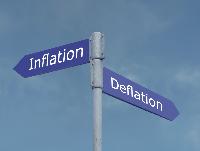
Deflation refers to the situation of general decline in prices. General decline means prices of most commodities and services are coming down. It is the opposite situation of inflation.
Causes of deflation
Deflation is generally caused by reduced demand and consumption in the economy. Reduced expenditure by consumers, business people and government brings down demand and thus causes deflation. Lower demand means reduced takers for goods and services and in this way prices of commodities will come down to make them saleable.
What makes the consumption, investment and government expenditure to decrease? There are many factors – reduction in money supply by the central bank, reduced credit or loans by the banking system, decreased investment expenditure by business people and reduced budget spending by government; all causes decline in demand and produces deflation.
Why deflation is dangerous than inflation?
Both inflation and deflation are bad for the economy. But of the two, deflation is more dangerous. If prices of goods are coming down, business people will stop investment as there is the risk of loss. In this way, deflation discourages many desirable factors in the economy – production, investment, employment and thus economic growth.
The major side effect is that it is a disincentive for the producers. Gradually, deflation can worsen into a recession and depression. It is often said that among the two undesirables- inflation and deflation; deflation is more dangerous. Deflation discourages the business psychologically. It adversely affects business momentum. Massive deflation may develop into depression as happened during 1920s. Hence, Central banks always try to avoid deflation.
On the other hand, in the case of inflation, mild level of inflation incentivizes production and investment activities. This in turn increases level of employment and economic growth. From the angle of business momentum low inflation is a desirable factor.
The definition of price stability also tells us that low level of inflation is preferable to deflation. Price stability is the most important objective of central bank’s monetary policy. Price stability is defined as low and stable inflation. There is no meaning that price stability is absence of inflation. Rather, low level of inflation is a welcome factor that may stimulate the economy.
In India, the RBI considers that 4% inflation is good for the economy. In the US, the central bank has a 2% inflation target.
Why deflation at present in many developed countries?
At present, deflationary situation prevails in most developed countries. Countries like US and Japan are designing monetary policies to achieve a target level of inflation. Still, inflation doesn’t occur in these economies.
The main reason for deflation in these economies is low consumption and low investment expenditure. Overall demand is low in these economies. There are no takers for already produced commodities. Because of the low demand, there are no incentives for businesses to expand investment. Deflation in these economies raises unemployment and brings down economic growth.
*********









